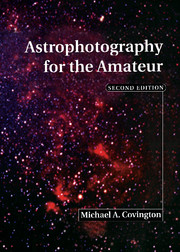Book contents
- Frontmatter
- Dedication
- Contents
- Preface
- Notes to the reader
- Symbols usued in formulae
- I SIMPLE TECHNIQUES
- II ADVANCED TECHNIQUES
- III PHOTOGRAPHIC TECHNOLOGY
- IV DIGITAL IMAGING
- APPENDICES
- A Exposure tables
- B Mathematical analysis of polar-axis misalignment
- C Plans for an electronic drive corrector
- D Film data
- E Photographic filters
- F Organizations and resources
- Bibliography
- Index
D - Film data
Published online by Cambridge University Press: 05 September 2013
- Frontmatter
- Dedication
- Contents
- Preface
- Notes to the reader
- Symbols usued in formulae
- I SIMPLE TECHNIQUES
- II ADVANCED TECHNIQUES
- III PHOTOGRAPHIC TECHNOLOGY
- IV DIGITAL IMAGING
- APPENDICES
- A Exposure tables
- B Mathematical analysis of polar-axis misalignment
- C Plans for an electronic drive corrector
- D Film data
- E Photographic filters
- F Organizations and resources
- Bibliography
- Index
Summary
The following pages are excerpts from film data booklets, reproduced by permission of Eastman Kodak Company. The films covered are:
• Kodak Technical Pan Film (black-and-white)
• Kodak Professional Ektachrome Film E200 (color slides)
• Kodak Professional Ektapress Films (color negatives)
To save space, some information not relevant to astrophotography has been left out. Complete, up-to-date data booklets are available from Kodak and other film manufacturers.
Because products change frequently, you should always use the most current information. These data sheets will remain useful as a basis of comparison for evaluating newer products.
Kodak Technical Pan Film (TP)
From Kodak Publication P-255, June, 1996. Copyright © 1996 Eastman Kodak Company
DESCRIPTION
KODAK Technical Pan Film is Kodak's slowest and finest-grained black-and-white film for pictorial photography (when developed in KODAK TECHNIDOL Liquid Developer). It is a variable-contrast panchromatic film with extended red sensitivity; because of its extended red sensitivity, it yields prints with a gray-tone rendering slightly different from that produced by other panchromatic films. (This is most noticeable in portraits, in which it suppresses blemishes.)
Use this film for pictorial, scientific, technical, and reversal-processing applications. It is an excellent choice for making big enlargements or murals.
APPLICATIONS
You can vary the contrast of KODAK Technical Pan Film by modifying development. The wide range of contrast levels, along with the spectral sensitization and combination of speed and image-structure properties, makes this film unusually versatile and suitable for many applications:
• Pictorial photography
• Photomicrography
• Microphotography (Microfilming)
[…]
- Type
- Chapter
- Information
- Astrophotography for the Amateur , pp. 290 - 306Publisher: Cambridge University PressPrint publication year: 1999

